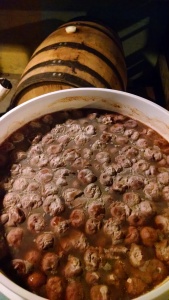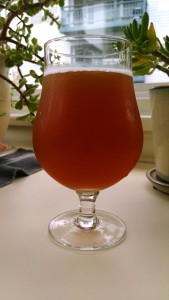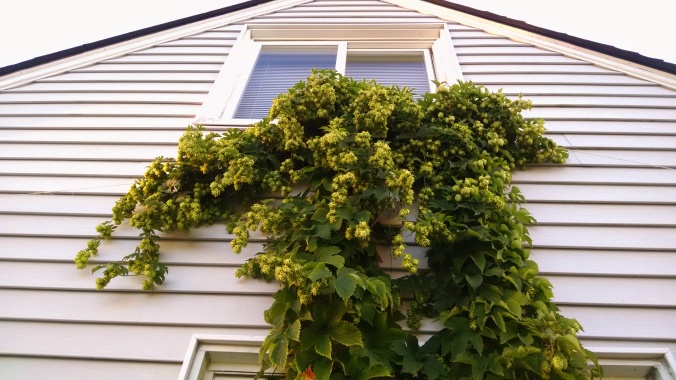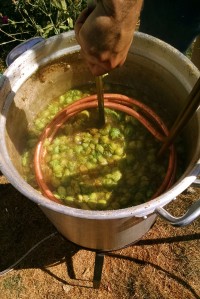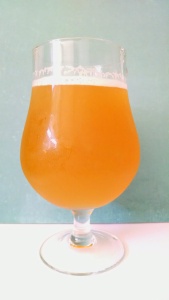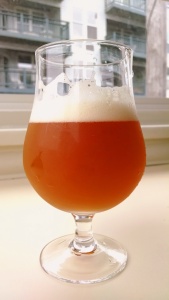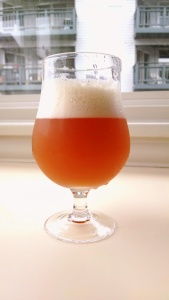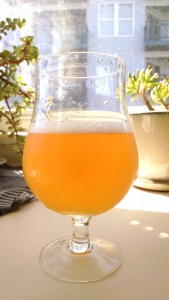
We like to keep up with trends and fads in the beer world — it helps to keep recipe development skills sharp, it can present a challenge, and it’s down-right fun (especially when you enjoy the styles that come into vogue). At this moment, so called New England, or juice/smoothie style ales (usually IPAs) are all the rage here in Seattle.
As I understand it, this style is actually a confluence of two different but similar brewing processes that emerged sometime in the last decade but have only recently infiltrated the zeitgeist. Most beer enthusiasts attribute the style to Vermont’s The Alchemist Brewery and their flagship IPA Heady Topper (hence the “New England” moniker); however, Stockholm’s Omnipollo has been producing juice/smoothie IPAs for quite a while as well. Regardless of who the progenitor of the style may be, a few key factors have coalesced to help us brewers and imbibers determine what makes a “juice-style” ale.
First and foremost is the water profile. To aid in achieving a softer mouthfeel, most research recommends a higher ratio of calcium chloride to calcium sulfate (gypsum) in the treatment of your liquor. Some brewers will also dough in at a higher temperature to accentuate the roundness of body and mouthfeel. Next is the addition of more flaked grains in the malt bill — this adds body, head retention, and haze to the finished beer. To get the desired smooth, bright and juicy flavors associated with oranges, pineapple, grapefruit, and mango, it is important to keep early bittering hop additions very low, or to skip them altogether in the hops schedule. Many brewers choose to first-wort hop and then add the bulk of their additions from five minutes to flame-out, while aggressively dry-hoping the beer in primary and secondary with hops like El Dorado, Citra, Mosaic, Amarillo, Nelson Sauvin, Galaxy, etc.
Omnipollo regularly adds lactose or oat milk to their juice/smoothie IPAs, while The Alchemist reportedly doesn’t bump their flaked oat content, relying on the massive quantities of late addition hops and abstaining from filtering to achieve the haze in their New England IPAs.
Gregory and I decided to brew a hoppy and sessionable “juice style” pale ale for the PNW summer we’ve been enjoying. We did slightly bump our usual approximate 1:1 chloride to sulfate ratio, but following Scott Janish’s excellent article Mouthfeel Softness | New England IPAs, we bucked traditional wisdom and decided to slightly accentuate the sulfate content for an approximate 1:1.7 ratio.
Our recipe, process, and tasting notes can be found after this brief and exciting announcement:
Gregory and I, along with partner Chris Richardson are turning our love and passion for beer and brewing into a full-time business venture by opening Best of Hands Barrelhouse in the West Seattle neighborhood! We will begin operations on a 7BBL direct-fire system and we aim to open our doors winter of this year or early 2018. We are currently demolishing and making repairs at the space, and awaiting our construction permits. You can read about the iconic building we’re leasing here, and please follow us on our Facebook page for updates on our progress!
Juice it Up, Bro!
Recipe Specifics
Batch Size (Gal): 15
Total Grain (Lbs): 28.00
Anticipated OG: 1.049
Anticipated SRM: 4.0
Anticipated IBU: 35
Brewhouse Efficiency: 75%
Wort Boil Time: 60 Minutes
Grain
42.86% — 12.00 Lbs. US 2-Row
28.57% — 8.00 Lbs. Red Wheat
14.29% — 4.00 Lbs. Flaked Oats
07.14% — 2.00 Lbs. Flaked Wheat
03.57% — 1.00 Lbs. Honey Malt
03.57% — 1.00 Lbs. Rice Hulls (@10 min.)
Hops
1.00 oz. El Dorado (Pellet, 16.0% AA) @ 60 min. (First Wort)
0.50 oz. Citra (Pellet, 13.8% AA) @ 60 min. (First Wort)
0.50 oz. Citra (Pellet, 13.8% AA) @ 60 min.
6.00 oz. Citra (Pellet, 13.8% AA) @ 0 min.
5.00 oz. Mosaic (Pellet, 12.5% AA) @ 0 min.
3.00 oz. El Dorado (Pellet, 16.0% AA) @ 0 min.
2.50 oz. Citra (Pellet, 13.8% AA) @ 4 days (Dry Hop)
2.00 oz. Mosaic (Pellet, 12.5% AA) @ 4 days (Dry Hop)
1.50 oz. El Dorado (Pellet, 16.0% AA) @ 4 days (Dry Hop)
2.50 oz. Citra (Pellet, 13.8% AA) @ 3 days (Dry Hop)
2.00 oz. Mosaic (Pellet, 12.5% AA) @ 3 days (Dry Hop)
1.50 oz. El Dorado (Pellet, 16.0% AA) @ 3 days (Dry Hop)
Extras
3.00 tsp Yeast Nutrient @ 10 min.
Yeast
Imperial Yeast A24 — Dry Hop
Water Profile
Seattle
9.00g Calcium Chloride
15.00g Gypsum
Mash Schedule
Single infusion – 60 min @ 151F
Mash out — 10 min @ 170F
Notes
Brewed on 07.11.17 with Gregory
07.11.17 — Chilled wort to 70F & pitched the yeast into 17 gallon SS Brewtech conical
07.13.17 — Vigorous fermentation activity
07.15.17 — Added half of the dry-hop addition in primary
07.18.17 — Dumped the yeast and added the remainder of the dry-hop addition
07.21.17 — Kegged the batch and began force carbonating
 Tasting Notes — 07.27.17 (on draft)
Tasting Notes — 07.27.17 (on draft)
Opaque hazy orange in color with billowy white head stand which persists throughout drinking. Intense satsuma orange and red grapefruit notes on the nose with a hint of minerality in the background. The citrus notes dominate the round palate with some hints of pineapple-like tropical fruit juiciness. Because we mashed at a lower temperature, the beer finishes quite dry with the impression of coarse tannic mango, and a long lingering grapefruit pith bitterness.
Calculated OG: 1.046
Calculated FG: 1.010
Approx. ABV: 4.7%
 My buddy Hippie John picked me up some Wyeast 5151-PC Brettanomyces Claussenii, and on the heels of my last successful 100% Brett. beer, I decided to make another one (this one a bit more traditional). This beer was initially going to be a grisette with a large portion of Munich triticale malt in the grist, but it evolved into a hoppier beer. I utilized some recent favorites in my hops schedule, and a delicious tropical fruit bomb beer is the result! Recipe and tasting notes follow:
My buddy Hippie John picked me up some Wyeast 5151-PC Brettanomyces Claussenii, and on the heels of my last successful 100% Brett. beer, I decided to make another one (this one a bit more traditional). This beer was initially going to be a grisette with a large portion of Munich triticale malt in the grist, but it evolved into a hoppier beer. I utilized some recent favorites in my hops schedule, and a delicious tropical fruit bomb beer is the result! Recipe and tasting notes follow:






